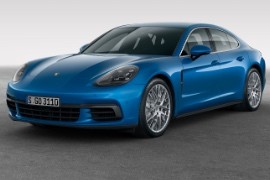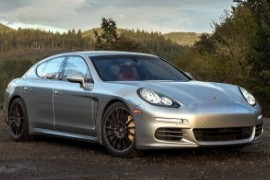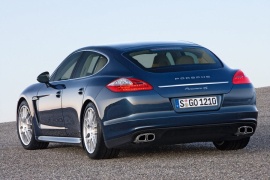PORSCHE Panamera 4S Models/Series Timeline, Specifications & Photos
First production year: 2009
Engines: Gasoline
Porsche dreamed about a 4-door saloon hard and long until it got real. The original prototype was in the late '80s and it was named 989. But it wasn't real until the first Panamera appeared, a car that made the same numbers of friends and enemies.
The second generation of the Panamera showed up in 2016 and its design fixed all the problems of the first generation. The nice look of a four-door coupe, combined with the exterior details of the vehicle, made it up for those who waited and trusted the Porsche brand. It looked like a stretched 911 model, but with the engine in the front. The 4-LED headlights fitted as standard were one of the key design elements that made the car attractive. The Panamera 4S featured 19” light-alloy wheels and only two colors as standard: black and white as standard.
The infotainment system can be paired with either a Bose or a Burmeister premium sound system for a better audio quality offered as an option. The system can be paired with a smartphone via a Porsche dedicated app. The Android Auto was not available.
For the engines, the Panamera 4S was available wither with a V6-gasoline, twin-turbo, or with a turbodiesel unit. Both versions were mated as standard to an 8-speed automatic PDK (Porsche dual-clutch) transmission and all-wheel-drive.
The Panamera 4S was more like a detuned Panamera Turbo rather than an upgraded Panamera 4, especially since it featured a twin-turbo engine under the hood.
Despite the slow and painful recovery from the world economic crisis, the Panamera found its way on the market. While the Europeans aimed for the diesel version, the rest of the world was busy with the gasoline-powered versions. The Panamera 4S was the middle ground between the mighty Turbo and the base model.
A major improvement for the Panamera S was the standard bi-xenon headlights and the option for full LED lamps. The daytime running lights were fitted with light-emitting diodes as standard. The revised front and rear bumpers brought a more aggressive look for the car. The bigger side-scoops in the apron were inspired by those installed on the 911 range. A wider rear windscreen was installed on the new tailgate.
Inside, the manufacturer installed the PCM (Porsche Communication Management) for the infotainment system. It supported Apple CarPlay connectivity, but its compatibility with Android phones was limited. The tachometer was mounted in the middle of the instrument cluster, with a round TFT display on its right side, where the navigation system could have been shown, as well as other on-board computer information.
The biggest change for the 2013 Panamera S was under the hood, where a twin-turbo 3.0-liter V6 engine was installed. It replaced the older 4.8-liter naturally aspirated unit. It was a win-win combination since it offered 20 hp more and it was more fuel-efficient. Unlike its predecessor, it was available exclusively with a 7-speed automatic (PDK – dual-clutch). The all-wheel-drive system was carried over, but the final drive was different to allow better fuel-efficiency. The Panamera 4S was available with a long wheelbase as well, for specific markets.
Along with the introduction of the Panamera range at the 2009 Shanghai Auto Show, Porsche introduced the 4S version as well. It was one of the best-balanced versions of its stablemates.
The idea of a four-door Porsche was not new. It was tried in the late '80s with the 989 concept car, which was based on the 911 platform. Later on, two four-doors Porsche 928s were tried by the German car-maker. After more effort, the engineering team succeeded to make the Panamera.
A four-door Porsche was hard to understand and to be accepted by some fans, but it was necessary. Those who owned a 911 needed a 4-door car to enjoy driving it daily with all the comfort and requirements from a daily driver. The Panamera was an evolution from the 928, with a front-engine and rear-wheel-drive architecture. The headlights were inspired by those installed on the Cayenne and the sloped back resembled a 911. A pair of vents were installed behind the front wheel arches. The taillights were similar to those found on the Cayman.
Inside, the Panamera designers took their inspiration from the luxury Vertu mobile phones. A four-seat layout was the only option, with a big center console that separated the driver from the other passengers. In the back, there was a decent room for adults and since it was a hatchback it could get an impressive luggage room, for a Porsche.
For the drivetrain, Porsche chose Cayenne as an inspiration model installing the 4.8-liter V8 engine under the hood. For the Panamera 4S, it fitted the car with an all-wheel-drive system and a 7-speed automatic (PDK – double-clutch) gearbox. The 400 hp Porsche 4-door hatchback was good for a 5-second run from 0 to 100 kph (0-62 mph).


